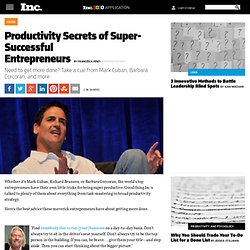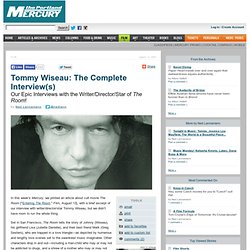

Productivity Secrets of Super-Successful Entrepreneurs. Whether it's Mark Cuban, Richard Branson, or Barbara Corcoran, the world's top entrepreneurs have their own little tricks for being super productive.

Good thing Inc.'s talked to plenty of them about everything from task-mastering to broad productivity strategy. Here's the best advice these maverick entrepreneurs have about getting more done. "Find somebody else to run [your] business on a day-to-day basis. Don’t always try to sit in the driver’s seat yourself. --Sir Richard Branson, founder of the Virgin Group "The productiveness of any meeting depends on the advance thought given the agenda, and you should never leave a meeting without writing a follow-up list with each item assigned to one person.
--Barbara Corcoran, founder of Corcoran Group "I carry my laptop with me everywhere. --Gary Vaynerchuk, founder of VaynerMedia "I usually get up at 6:30 and go to a Pilates class near my house. --Trina Turk, fashion designer "Meetings are a waste of time unless you are closing a deal. American Farmland Trust. Studio Zappa. Tommy Wiseau: The Complete Interview(s) In this week's Mercury, we printed an article about cult movie The Room ["Entering The Room," Film, August 13], with a brief excerpt of our interview with writer/director/star Tommy Wiseau, but we didn't have room to run the whole thing.

Set in San Francisco, The Room tells the story of Johnny (Wiseau), his girlfriend Lisa (Juliette Danielle), and their best friend Mark (Greg Sestero), who are trapped in a love triangle—as depicted by numerous and lengthy love scenes set to the swankiest music imaginable. Other characters drop in and out—including a man-child who may or may not be addicted to drugs, and a shrew of a mother who may or may not have cancer—as plot threads are introduced, then instantly abandoned. It's a really fun movie to watch, especially with friends. I was a little nervous to speak with Tommy Wiseau, writer/producer/director/star of The Room. Actually, Wiseau was remarkably friendly and candid, and willing to go off-book for our interview. You should ask them. No. Yes. A Scientific Breakthrough Lets Us See to the Beginning of Time : The New Yo. At rare moments in scientific history, a new window on the universe opens up that changes everything.

Today was quite possibly such a day. At a press conference on Monday morning at the Harvard-Smithsonian Center for Astrophysics, a team of scientists operating a sensitive microwave telescope at the South Pole announced the discovery of polarization distortions in the Cosmic Microwave Background Radiation, which is the observable afterglow of the Big Bang. The distortions appear to be due to the presence of gravitational waves, which would date back to almost the beginning of time.
This observation, made possible by the fact that gravitational waves can travel unimpeded through the universe, takes us to 10-35 seconds after the Big Bang. By comparison, the Cosmic Microwave Background—which, until today, was the earliest direct signal we had of the Big Bang—was created when the universe was already three hundred thousand years old. However, consistency is not enough in science. Sumofnaturals.
By Dr.

Tony Padilla What do we get if we sum all the natural numbers? This was the question we asked in our recent Numberphile video. The answer we gave was, to the surprise of many I'm sure, -1/12. It's by no means obvious, but this is the only sensible value one can attach to this divergent sum. Nevertheless, having read the comments, tweets and blogs, if I were to ask again "what do we get if we sum the natural numbers? " To the second class of viewers who objected to my "proof" in the video, let me say this. Analytic continuation is used all over Physics. Define three sequences in the complex plane, z \in \mathbb{C}S_1(z)=1+\sum_{n=1}^\infty (-1)^n \left[(n+1)^{-z}-n^{-z} \right] S_2(z)=\sum_{n=1}^\infty (-1)^{n+1} n^{-z} S(z)=\sum_{n=1}^\infty n^{-z}
Morgan Stanley's Gerard Minack Retires - Business Insider.
Images. Systems. Content Curation. Harvard Business. Kriipin Lomamkit - Lepolahti.